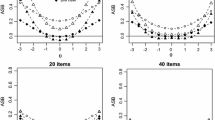Abstract
Maximum likelihood estimation of item parameters in the marginal distribution, integrating over the distribution of ability, becomes practical when computing procedures based on an EM algorithm are used. By characterizing the ability distribution empirically, arbitrary assumptions about its form are avoided. The Em procedure is shown to apply to general item-response models lacking simple sufficient statistics for ability. This includes models with more than one latent dimension.
Similar content being viewed by others
Reference notes
Thissen, D. Personal communication, 1979.
Thissen, D.Marginal maximum likelihood estimation for the one-parameter logistic model. Manuscript submitted for publication, 1981.
References
Andersen, E. B. Conditional inference for multiple-choice questionnaires.British Journal of Mathematical and Statistical Psychology, 1973,26, 31–44.
Andersen, E. B.Discrete statistical models with social science applications. Amsterdam: North-Holland, 1980.
Andersen, E. B. & Madsen, M. Estimating parameters of the latent population distribution.Psychometrika, 1977,42, 357–374.
Bartholomew, D. J. Factor analysis for categorical data (with Discussion).Journal of the Royal Statistical Society, Series B, 1980,42, 293–321.
Bock, R. D. Estimating item parameters and latent ability when responses are scored in two or more nominal categories.Psychometrika, 1972,37, 29–51.
Bock, R. D. Review ofThe dependability of behavioral measurements by Cronbach, L. J., Gleser, G. C., Nanda, H., & Rajaratnam, N.Science, 1972a,178, 1275A-1275A.
Bock, R. D., & Jones, L. V.The measurement and prediction of judgment and choice. Chicago: International Educational Services, 1980 (reprint).
Bock, R. D., & Lieberman, M. Fitting a response model forn dichotomously scored items.Psychometrika, 1970,35, 179–197.
Christoffersson, A. Factor analysis of dichotomized variables.Psychometrika, 1975,40, 5–32.
Dempster, A. P., Laird, N. M., & Rubin, D. B. Maximum likelihood from incomplete data via the EM algorithm (with Discussion).Journal of the Royal Statistical Society, Series B, 1977,39, 1–38.
Fischer, G. Linear logistic test model as an instrument in educational research.Acta Psychologica, 1973,37, 359–374.
Fischer, G. H. Individual testing on the basis of the dichotomous Rasch model. In L. J. T. Van der Kamp, W. F. Langerak, & D. M. N. de Gruijter (Eds).Psychometrics for Educational Debates. Chichester: Wiley, 171–188, 1980.
Goldstein, H. Dimensionality, bias, independence, and measurement scale problems in latent trait test score models.British Journal of Mathematical and Statistical Psychology, 1980,33, 234–246.
Haberman, S. J. Maximum likelihood estimates in exponential response models.Annals of Statistics, 1977,5, 815–841.
Kaiser, H. F. The varimax criterion for analytic rotation in factor analysis.Psychometrika, 1958,23, 187–200.
Kolakowski, D. & Bock, R. D.NORMOG: Maximum likelihood item analysis and test scoring; normal ogive model. Chicago: International Educational Services, 1973a.
Kolakowski, D. & Bock, R. D.LOGOG: Maximum likelihood item analysis and test scoring; logistic model for multiple item responses. Chicago: International Educational Services, 1973b.
Laird, N. M. Nonparametric maximum likelihood estimation of a mixing distribution.Journal of the American Statistical Association, 1978,73, 805–811.
Lord, F. M. Practical applications of item characteristic curve theory.Journal of Educational Measurement, 1977,14, 117–138.
Lord, F. M.Applications of item response theory to practical testing problems. New York: Erlbaum Associates, 1980.
Lord, F. M., & Novick, M. R.Statistical theories of mental test scores. Reading (Mass.): Addison-Wesley, 1968.
Micko, H. C. A psychological scale for reaction time measurement.Acta Psychologica, 1969,30, 324–335.
Muthén, B. Contributions to factor analysis of dichotomized variables.Psychometrika, 1978,43, 551–560.
Ramsay, J. O. Solving implicit equations in psychometric data analysis.Psychometrika, 1975,40, 337–360.
Rao, C. R.Linear statistical inference and its applications (2nd ed.). New York: Wiley, 1973.
Samejima, F. Estimation of latent ability using a response pattern of graded scores.Psychometric Monograph, No. 17, 1969.
Sanathanan, L. & Blumenthal, S. The logistic model and estimation of latent structure.Journal of the American Statistical Association, 1978,73, 794–799.
Scheiblechner, H. Das Lernen und Losen komplexer Denkaufgaben.Zeitschrift fur Experimentelle und Angewandte Psychologie, 1972,19, 476–506.
Stroud, A. H., & Sechrest, D.Gaussian quadrature formulas. Englewood Cliffs (N.J.): Prentice-Hall, 1966.
Thurstone, L. L.Multiple factor analysis. Chicago: University of Chicago Press, 1947.
Wood, R. L. Wingersky & Lord, F. M.LOGIST: A computer program for estimating examinee ability and item characteristic curve parameters. Princeton (N.J.): Educational Testing Service, 1976.
Wright, B. D. & Panchapakesan, N. A. A procedure for sample-free item analysis.Educational and Psychological Measurement, 1969,29, 23–48.
Author information
Authors and Affiliations
Additional information
Supported in part by NSF grant BNS 7912417 to the University of Chicago and by SSRC (UK) grant HR6132 to the University of Lancaster.
We are indebted to Mark Reiser and Robert Gibbons for computer programming. David Thissen clarified a number of points in an earlier draft.
Rights and permissions
About this article
Cite this article
Bock, R.D., Aitkin, M. Marginal maximum likelihood estimation of item parameters: Application of an EM algorithm. Psychometrika 46, 443–459 (1981). https://doi.org/10.1007/BF02293801
Received:
Revised:
Issue Date:
DOI: https://doi.org/10.1007/BF02293801




